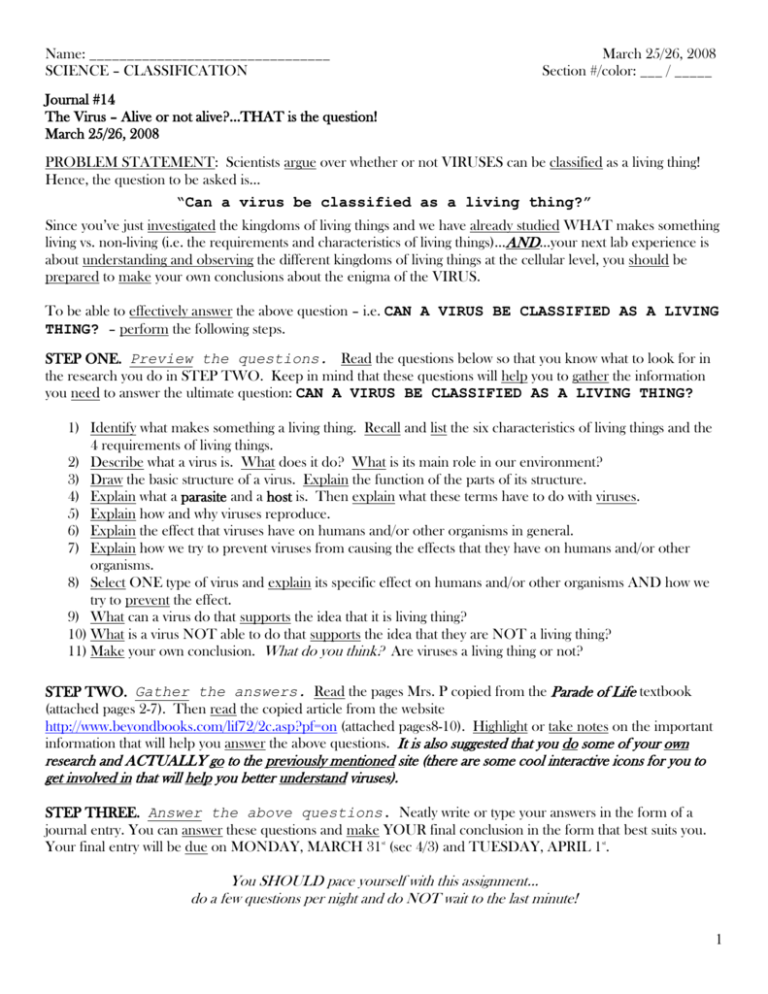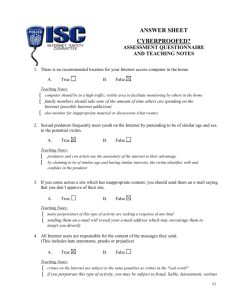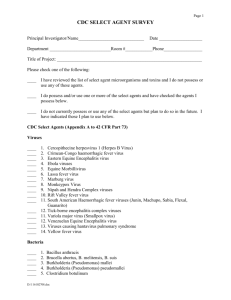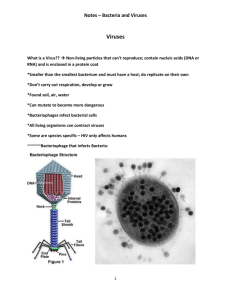
Name: ________________________________
SCIENCE – CLASSIFICATION
March 25/26, 2008
Section #/color: ___ / _____
Journal #14
The Virus – Alive or not alive?…THAT is the question!
March 25/26, 2008
PROBLEM STATEMENT: Scientists argue over whether or not VIRUSES can be classified as a living thing!
Hence, the question to be asked is…
“Can a virus be classified as a living thing?”
Since you’ve just investigated the kingdoms of living things and we have already studied WHAT makes something
living vs. non-living (i.e. the requirements and characteristics of living things)…AND…your next lab experience is
about understanding and observing the different kingdoms of living things at the cellular level, you should be
prepared to make your own conclusions about the enigma of the VIRUS.
To be able to effectively answer the above question – i.e. CAN A VIRUS BE CLASSIFIED AS A LIVING
THING? – perform the following steps.
STEP ONE. Preview the questions. Read the questions below so that you know what to look for in
the research you do in STEP TWO. Keep in mind that these questions will help you to gather the information
you need to answer the ultimate question: CAN A VIRUS BE CLASSIFIED AS A LIVING THING?
1) Identify what makes something a living thing. Recall and list the six characteristics of living things and the
4 requirements of living things.
2) Describe what a virus is. What does it do? What is its main role in our environment?
3) Draw the basic structure of a virus. Explain the function of the parts of its structure.
4) Explain what a parasite and a host is. Then explain what these terms have to do with viruses.
5) Explain how and why viruses reproduce.
6) Explain the effect that viruses have on humans and/or other organisms in general.
7) Explain how we try to prevent viruses from causing the effects that they have on humans and/or other
organisms.
8) Select ONE type of virus and explain its specific effect on humans and/or other organisms AND how we
try to prevent the effect.
9) What can a virus do that supports the idea that it is living thing?
10) What is a virus NOT able to do that supports the idea that they are NOT a living thing?
11) Make your own conclusion. What do you think? Are viruses a living thing or not?
STEP TWO. Gather the answers. Read the pages Mrs. P copied from the Parade of Life textbook
(attached pages 2-7). Then read the copied article from the website
http://www.beyondbooks.com/lif72/2c.asp?pf=on (attached pages8-10). Highlight or take notes on the important
information that will help you answer the above questions. It is also suggested that you do some of your own
research and ACTUALLY go to the previously mentioned site (there are some cool interactive icons for you to
get involved in that will help you better understand viruses).
STEP THREE. Answer the above questions. Neatly write or type your answers in the form of a
journal entry. You can answer these questions and make YOUR final conclusion in the form that best suits you.
Your final entry will be due on MONDAY, MARCH 31st (sec 4/3) and TUESDAY, APRIL 1st.
You SHOULD pace yourself with this assignment...
do a few questions per night and do NOT wait to the last minute!
1
(FROM PARADE OF
LIFE)
2
3
4
5
6
7
(FROM BEYOND BOOKS)
Are Viruses Alive?
Are viruses alive?
Anyone with a cold or the flu virus feels as if they are under
attack by some organism. But in the scientific community
it's still an open-ended question. This is why viruses do not
belong to a kingdom of living things. Just because a virus
seems alive doesn't mean it is alive. After all, it's not even a
single-celled organism.
HIV attacks the immune system's helper T cells.
A virus is little more than a strand of DNA or RNA covered
by a protein coating. Viruses are a thousand times smaller
than bacteria and come in a wide range of shapes. Some look like weird, tall spiders whereas
others look like prickly porcupinelike soccer balls.
One thing is for sure; viruses are very much a part of life on
Earth and the human experience. Viruses infect animals,
plants, and even bacteria. Humans are in a constant battle
with viruses. HIV (the virus that causes AIDS), the Ebola virus,
and the West Nile virus continue to make headlines and take
millions of lives.
Vaccines
Chicken pox.
Measles. Mumps.
Polio. Rubella.
Sound familiar? Your
doctor probably gave
you vaccination shots
when you were a
baby to protect you
from these horrible diseases.
Other maladies, such as colds, the flu, chicken pox, measles,
and hepatitis, are more common, but sometimes just as
deadly. Symptoms vary depending on which kind of cell is under attack. Cold viruses attack the
nose and throat, the rabies virus attacks the brain and nervous system, and the human
immunodeficiency virus (HIV) attacks white blood cells in the bloodstream. Viruses can even
cause some kinds of cancers and leukemia.
Live and Let Die
To determine whether a virus is alive or not, we could compare the virus's characteristics to what
many biologists consider the requirements of life. All living things have several common
characteristics. Some nonliving things may have one or more of the characteristics but not all of
them. For a virus then to be classified as alive it must:
Be Made of Cells
Metabolize (ingest, digest, respire, excrete)
Move
Respond to stimuli/
Reproduce
Grow and develop
8
Viruses do have DNA or RNA, and DNA is the code for life.
Having genetic material is an important step towards being
classified as alive. DNA controls the evolution of the cell and
the organism. Like living things, viruses evolve through time
and thus can adapt to their environment. But unlike cells,
viruses cannot use their genetic material by themselves.
They need a living cell in order to function and reproduce;
otherwise they are playing dead.
Resistance Is Futile
Because viruses are not cells, they can't divide by binary
fission like bacteria. Yet they do reproduce themselves in an
This may look like a space capsule, but it's
extraordinary way. Their structure enables viruses to attack
actually a virus. The top part is the capsid, the
a plant or animal cell called a HOST CELL. The protein shell
body is the sheath, and the tails at the bottom
protecting the virus's DNA is covered with spikelike
help the virus attach to its host.
protrusions. These spikes allow the virus to latch onto the
cells they infect. Once hooked on, the virus injects its genetic
material into the host cell.
The virus's DNA takes control of the cell once it's within the
cytoplasm and begins to make the cell produce virus DNA and
other parts of viruses. The host cell is forced to expend all of its
energy and resources to help the virus replicate and make
hundreds more viruses. The poor, weak cell usually bursts like an
overinflated balloon from all the viruses and is destroyed in the
process. Then, the replicated virus attaches itself to a new,
unaffected host cell, and the viral infection continues.
Living things do more than just reproduce. They also must obtain
food to fuel the cell's metabolic activity. Some organisms, such as
animals, eat other living things for energy. Other organisms, such
as plants, harness the Sun's energy to make their own food.
Because viruses aren't cells and have no activity within it, it has no need for food. However, the
virus-controlled host cell needs material and energy to reproduce the viruses. Maybe viruses can
fit the requirement that life forms need to obtain and use energy.
An animation of a virus infecting a
host cell.
All other living things also grow or get bigger. A virus does nothing inside its protein coat; therefore
it does not grow. But some scientists argue that a virus's growth occurs inside the host cell where
parts of viruses are built during reproduction.
Plants and animals react to the environment. All living things have ways of sensing the world
around them and can respond to changes in their environment. Do viruses react? Viruses cannot
move themselves, but there are some differences in opinion that viruses do react to changes in
the environment.
Remember, the virus's DNA or RNA can evolve over time, thereby increasing its chances for
survival and adapting to the environment. Like bacteria, they adapt through genetic mutations
caused by rapid reproduction. That is why it is so hard to cure viral diseases. Viruses keep
changing their DNA and protein coat to further their "life form" and keep ahead of the game.
9
What's Your Final Answer?
As humans, we like to classify things because it helps us understand the physical world. Viruses
must have a host cell to live and reproduce. Outside of the host cell, viruses are pieces of genetic
molecules that can do nothing by themselves. Viruses are right on the border between living and
nonliving. Some biologists currently see the virus as a nonliving infectious particle. Other
biologists disagree and suggest they are alive because of what happens inside the host cell.
Getting a definite answer if viruses are alive or not may never happen.
But hey, that's life.
Copyright ©2006 Apex Learning Inc. All rights reserved. Patents D455,435 and D455,436.
Terms of Use | Privacy Policy
Call Toll Free 1-800-453-6227 • Fax 206-381-5601
10







